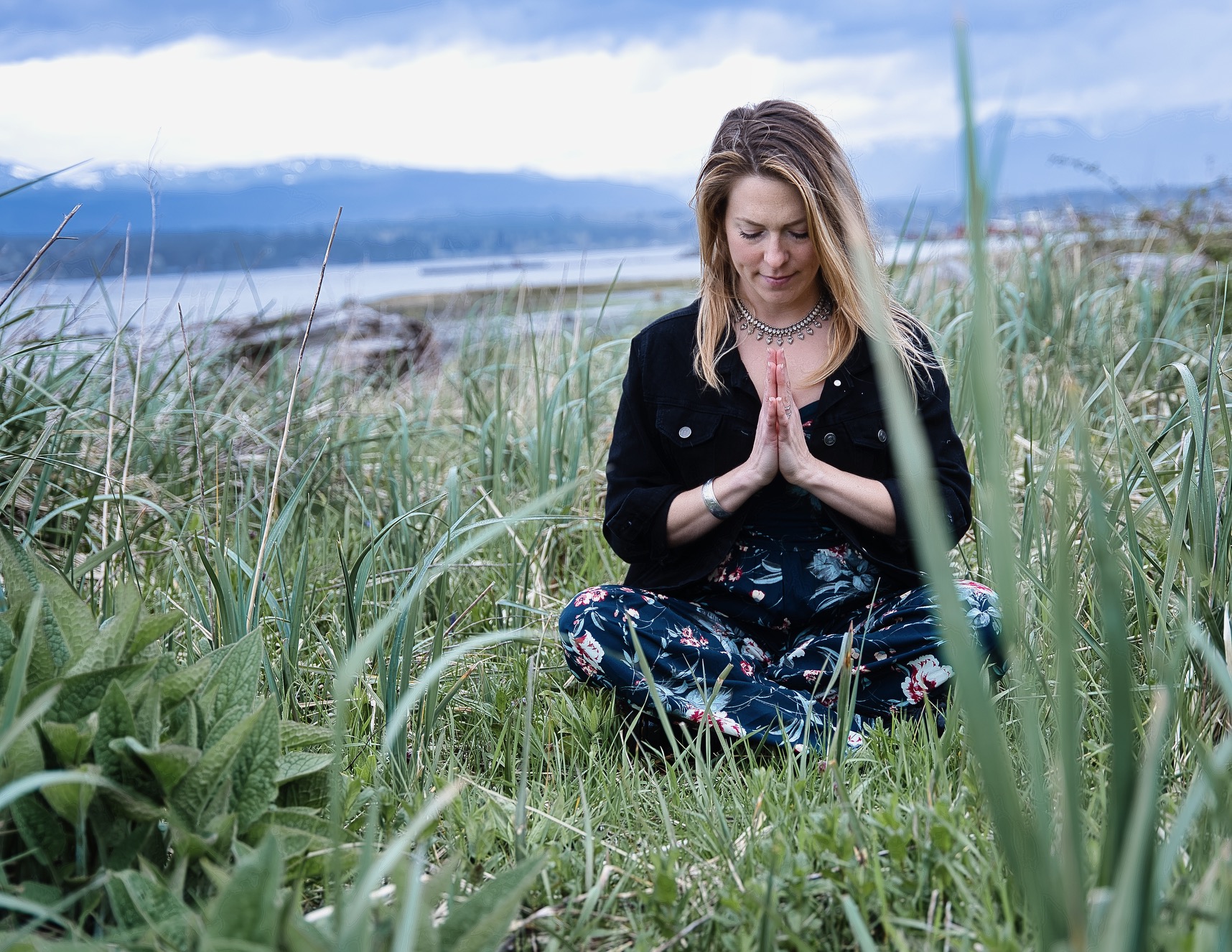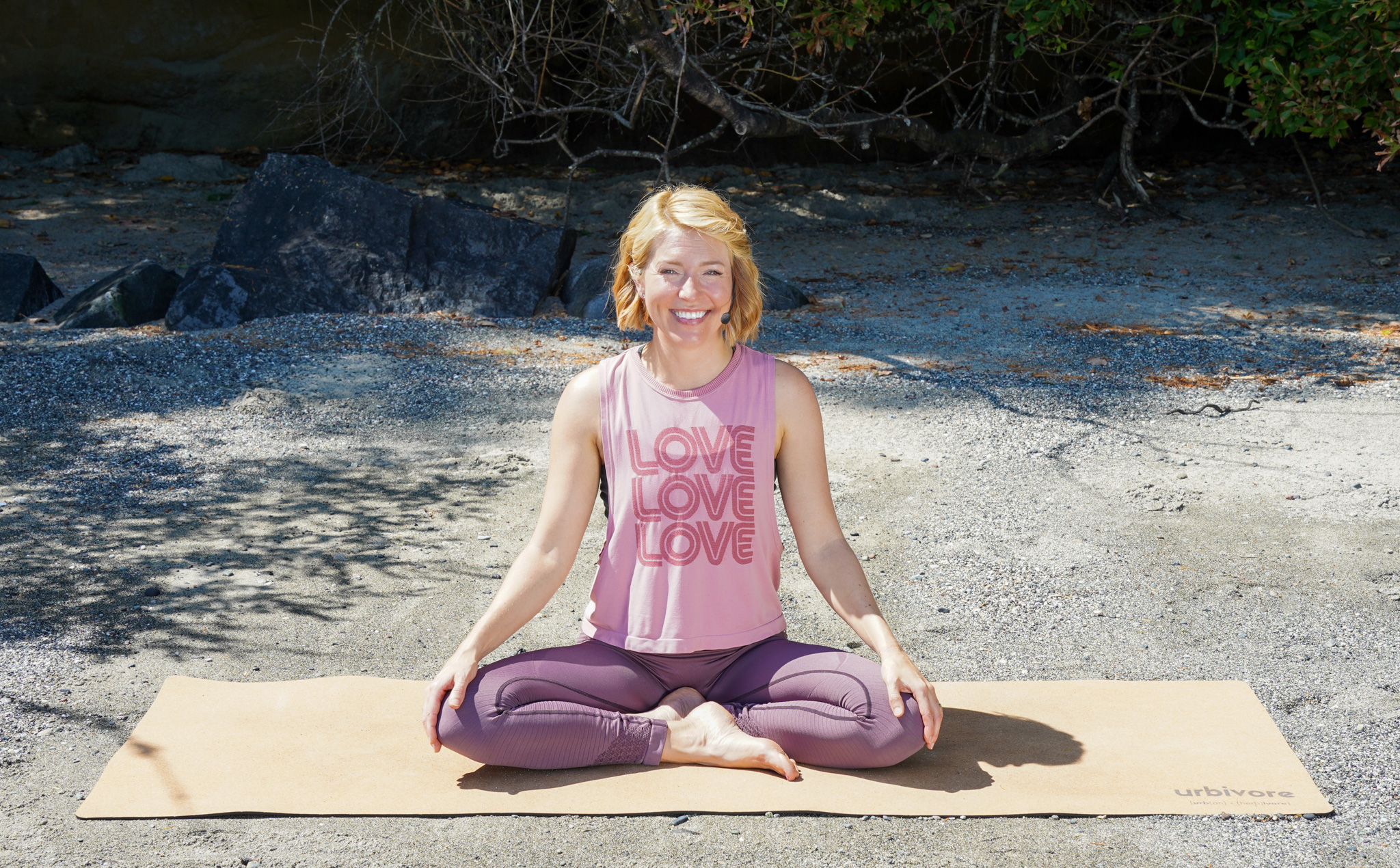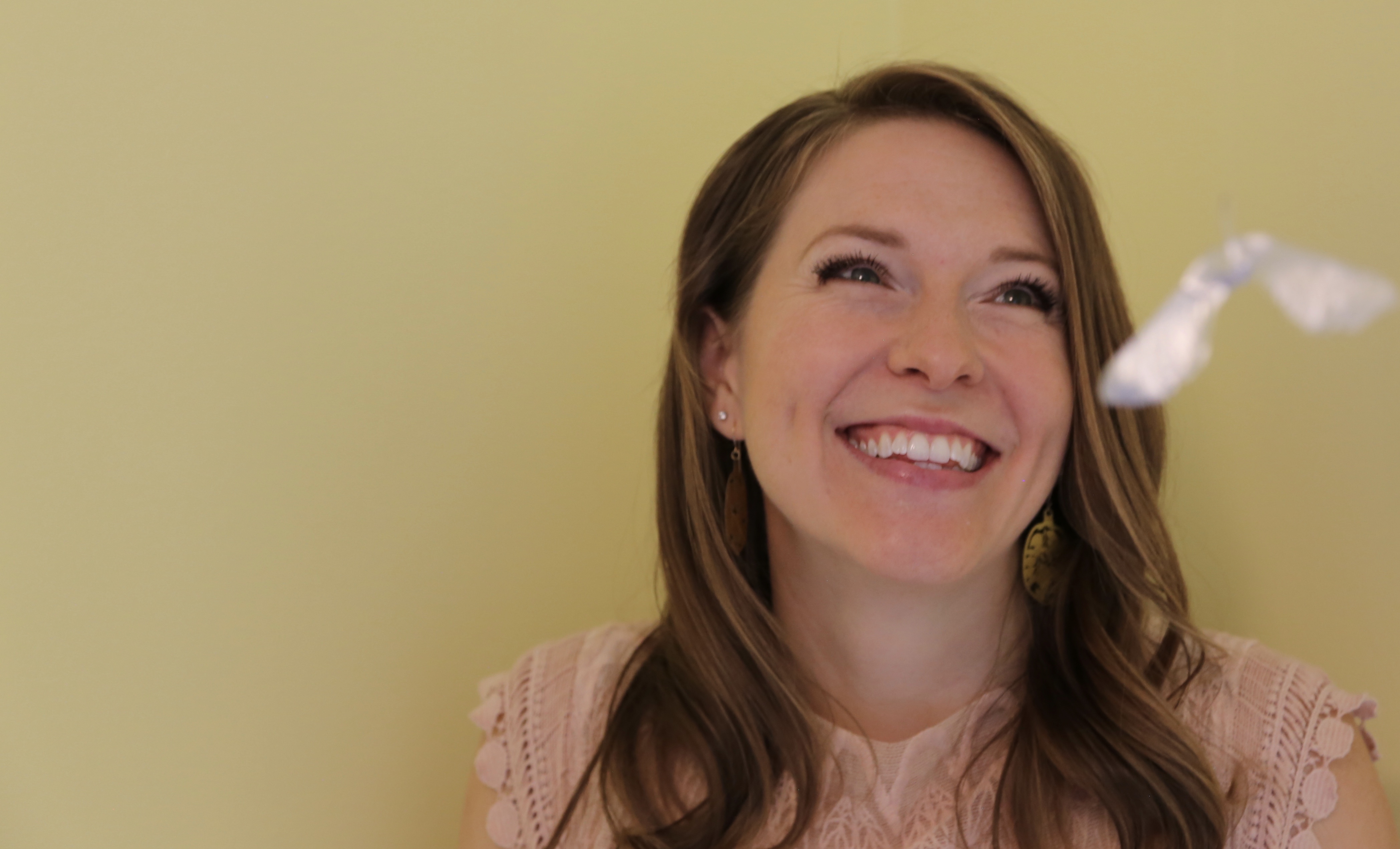This interview is from our new series: “The people that make DYWM.” Learn more about our instructors, their take on yoga, and what makes them tick.
Today, we’re shining the spotlight on Julia Crouch, a cherished member of the DYWM family. Like many of our beloved teachers, Julia found yoga during a transformative period in her life. Yoga helped her heal—physically, mentally, emotionally, and spiritually. Motivated by her personal experiences, she began her yoga teacher training in 2011. During the beginning of the pandemic in 2020 Julia filmed and edited an 8 part prenatal series all by herself. She approached the team at DYWM with her series and was quickly taken on. She has enjoyed working with and filming for them ever since.
Julia’s given us many amazing classes rooted in her passion to empower, nurture, and inspire the feminine in all of us, be it through prenatal/postnatal yoga, yoga for the female hormonal cycle, or yoga to reignite the feminine in a masculine world. In this interview, we dive deeper into these subjects, as well as her mission to help people reclaim their power in a world that generally tries to push us down.
Julia, could you start by sharing how your personal journey with yoga began and how it led you to specialize in women's health, particularly focusing on the menstrual cycle?
JC: My journey with yoga began in my late teens—I’d say there was a deep knowing that I needed a guiding practice to help navigate my life as it became more and more tumultuous. I often joke that I only started practicing yoga because I was working at a yoga clothing store when I was 19, though I had never actually tried it before! I was unable to touch my toes at the time and was extremely competitive and anxious. I attended my first yoga class in North Vancouver, Canada and I haven’t looked back since. I believe that yoga found me because I needed it for more than the clothes and the physical fitness. It has since helped me continue to learn and evolve into the person I am now happy to be (not a finite destination!).
Because yoga became such an anchoring part of my life, I think that it naturally steered me toward areas that I personally needed to heal and learn about. Areas where I felt we, collectively in our modern society, are suffering. When I became a mother for the first and then second time, I leaned immensely on yogic practices and learned under some absolutely amazing and empowering women and yogis. These practices helped me to heal after an extremely difficult first birth, and then a power-reclaiming, beautiful second birth experience. As a teacher at heart, I had to share what I had learned!
Since then, there has been no doubt in my mind that the generic current-day thought patterns around pregnancy, birthing, motherhood, menstruation, and womanhood are not serving most of us (those who identify as women).
One of the yamas (yogic guidelines) is ahimsa, which loosely translates to non-violence or non-harm. For me, part of my practice of ahimsa is educating others about the female hormonal cycle, birthing, and motherhood. By standing against the systems that oppress us, we are able to create a world with less violence, less pain and confusion, and more harmony. This is how I’ve come to practice yoga, although of course there are many amazing asanas (physical postures) to help with cramps and monthly hormonal fluctuations!
You've mentioned the transformative impact of yoga in your life, especially prenatal yoga and its role in your amazing second-birth experience. How can yoga help support women through their pregnancy?
JC: Because yoga is a practice of learning to know oneself, about getting curious about the painful and sticky stuff, and about connecting with the greater existence around us, it’s the perfect practice for anyone navigating the changes that come with pregnancy and parenthood.
Most prenatal yoga teachers out there can help any pregnant person with the aches and pains of a body that is growing life inside of it. There are beautiful calming practices, stretches, and relaxation techniques to help along the way. Most classes will focus on strengthening certain areas of the body to help support you as you grow, and to prepare you for the birthing process and subsequent recovery.
All prenatal classes are different, and depend very much on the teacher. My favourites are the ones that teach tangible coping strategies for birthing. This is how I teach in person—as a certified doula I’m thankful to have plenty of training and experience to draw on as well.
Many women experience different levels of discomfort during their menstrual cycle. In your experience, how can yoga serve as a tool for relief and empowerment during this time?
JC: Check out my Yoga for the Female Hormonal Cycle Series! I curated the four classes for each part of the hormonal cycle to best support your needs. I’ve since filmed a couple of extra classes for anyone needing varying support during menstruation and ovulation.
Class promotion aside, yoga asana can be a fantastic way to relieve aches and pains from the body. Whether it’s deep stretching, strengthening and mobility, or simply resting, the physical body can certainly benefit.
As I touched on before, so much of yoga is about getting to know yourself better—your energies, thoughts, emotions, wants, and needs. The more you’re able to practice and tap into this intrinsic knowing, the more you’ll be able to take care of yourself throughout your cycle. Talk about empowering!!! (For example, I now know not to act out on my thoughts and feelings the couple of days before my period starts. I almost always do better to sit with a gentle yoga practice and wait for later in my cycle when I’m less reactive and able to communicate more effectively!)
In your yoga for the female hormonal cycle program, you craft a different class for each phase: follicular, ovulatory, luteal, and menstrual. Could you take us through the different considerations that “dictate” the style, pace, and postures of each class?
JC: Great question! Most people have no idea our cycles can be broken up or labeled this way. I certainly didn’t until I started my quest to learn more!
The follicular stage of your cycle is when your hormones start to rise again following menstruation. I curated this class to help you celebrate your body during this time, focusing on creativity, rising energy levels, and nurturing your system in a way that will help set you up for the weeks to come.
The ovulatory stage is for the days during the height of your hormonal cycle when you’re ovulating and some, but not all, are feeling energized. Enjoy getting your energy moving and challenging yourself with some fun flows and movements.
During the luteal phase of your hormonal cycle, hormones steadily drop off until menstruation. During this phase, we often feel more in tune with what’s important in our lives and what we might need to wrap up or finish off. The class is specific for supporting your system during this time with a slower flow and thyroid stimulation.
As most people are aware of, the menstrual phase is when we shed our uterine linings and begin our cycles once more. Take the time to listen to your innate knowing and intuition, creating a restful space in your cycle to recharge and prepare to create anew in the weeks to come.

How can women start to tailor their yoga practice to their menstrual cycle?
JC: The best thing for a person looking to get in tune with their menstrual cycles is to start a quieter, more introspective practice. Start following your intuition and those tiny, subtle cues your body gives you—they can be as simple as, “What shall I eat for lunch today?” or “How do I truly, deeply, want to spend the next fifteen minutes?” From there, your intuition muscle, that listening-to-yourself muscle, begins to grow stronger.
Start to really check in with how you feel at different times of the month and be open to adapting your practice to what you need at certain times.
As a general guideline, people often feel more energized and explorative/creative during the follicular and ovulatory stages. Toward the end of the luteal phase, hormones are dropping rapidly and often, you may need a more restorative practice right before or for the first couple of days of your menstrual period. This might be a time for deeper introspection, meditation, and journaling. Some people feel a wonderful release with their periods and are literally ready to flow and move once they start. We are all so different, so take the time to get to know your cycle! Month to month, year to year, it’s a beautifully changing thing so get curious about what it can tell you and how it can be used to your advantage!

The way we live is often at odds with our bodies' natural processes. Can yoga be a part of the rebellion against this sort of so-called “modern” lifestyle?
JC: As I touched on with our first question, I definitely think so. The deeper knowing of ourselves and our purposes that comes with a dedication to practicing yoga will only lead us in a healthier direction for all. Often that means standing up against injustices.
Nutrition and hydration are also crucial during the menstrual cycle. Do you incorporate these elements into your teaching? How do they complement the physical practice of yoga?
JC: As a nutritional health coach, I love to touch on these aspects. Like everything else in life, nutrition is so specific to each individual and we need to honour that. Generally speaking, avoiding processed foods and replacing them with whole foods, fresh foods, and lots and lots of water is going to make you feel better on all levels. You’ll notice your body feel less lethargic and constricted. Your menstrual cycle will be more regular and fluid.

For women who may be experiencing severe menstrual pain or conditions like endometriosis or PCOS, are there specific yoga practices or postures you recommend?
JC: Restorative poses are always my go-to as they help to calm the nervous system and allow space for healing. I’m not a doctor and yoga isn’t a cure-all for any of these symptoms, though. I’d recommend seeking support from women’s health specialists along with your yoga practice.
For someone trying to be more in tune with their body’s needs and processes (like adding yoga to our menstrual health routine), are there any resources you recommend for further reading or practice?
JC: Books books books! Educate yourself as much as you can:
I'm a big fan of Alisa Vitti's book In the Flo, which is about living according to our cycle with lots of great info about how our entire worlds are built for men.
The Fifth Vital Sign: Master Your Cycles & Optimize Your Fertility by Lisa Hendrickson-Jack is another amazing educational piece that will have you not only understanding, but tuned into your cycle in no time.
If you're curious about fasting as it’s so popular these days, Dr. Mindy Pelz' Fast like a Girl is fantastic. Seriously, don’t fast any other way if you value your hormones, health and sanity!
Dr. Stacy Sims is doing AMAZING work for female athletes and training to suit their cycles as well as menopause transitions. Her book on female athletic training is called ROAR and she has since released another about training for menopause called Next Level.
And last but definitely not least: Dr. Christiane Northrup. She’s like the godmother of female healing in basically everything. I use her book, Women's Bodies, Women's Wisdom as my bible... I pick it up and flip open to whatever page is meant to land for me whenever I'm in the sauna. It's a huge volume.

Finally, in your globe-trotting, have you encountered any unique yoga practices or philosophies from other cultures that have influenced how you teach yoga for menstrual health?
JC: I have met so many amazing people and experienced glimpses of their cultures during my travels over the years. As a whole, I’d say I deeply appreciate the dedication to ritual and honoring of ancestors and the tried-and-true wisdom of the much longer-established cultures than that of those of the currently dominant population of North America.
Directly related to the female cycle, I have a Thai friend that I shared much time with in Saudi Arabia. She taught me about the importance of celebrating, nourishing, and protecting the energies and space of the new mother. I’ve since learned of many similar traditions around the world and they resonate with me deeply. As a result, I try to impart this importance in all my prenatal and postnatal classes. I also believe that this honouring practice absolutely extends further to all the female energies. There is nothing more precious than celebrating the creative flow that allows all human life to continue on this earth. I try—hopefully, with success—to encourage, support, hold, and empower those practicing in any yoga classes with me.
Namaste.



Comments
Existing Comments